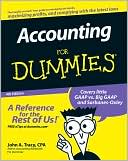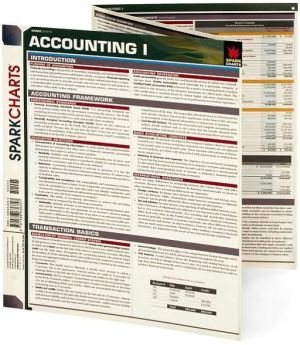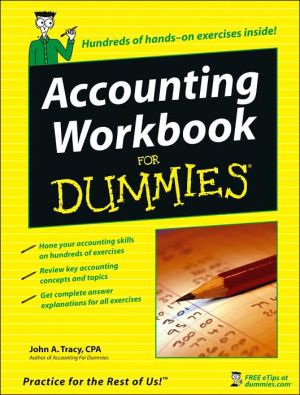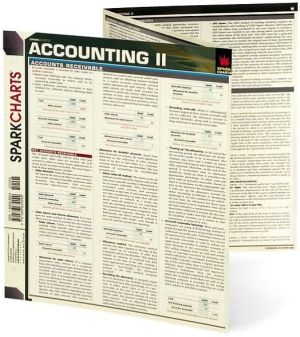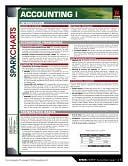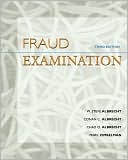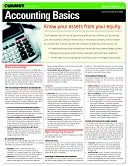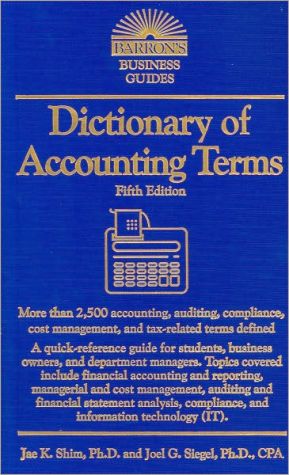CliffsQuickReview Accounting Principles II
CliffsQuickReview course guides cover the essentials of your toughest classes. Get a firm grip on core concepts and key material, and test your newfound knowledge with review questions.\ From budgeting, cost accounting, and liabilities to partnerships and corporations, CliffsQuickReview Accounting Principles II can help you understand and retain advanced accounting concepts. This guide introduces each topic, defines key terms, and walks you through each sample problem step-by-step. In no...
Search in google:
CliffsQuickReview course guides cover the essentials of your toughest classes. Get a firm grip on core concepts and key material, and test your newfound knowledge with review questions. From budgeting, cost accounting, and liabilities to partnerships and corporations, CliffsQuickReview Accounting Principles II can help you understand and retain advanced accounting concepts. This guide introduces each topic, defines key terms, and walks you through each sample problem step-by-step. In no time, you'll be ready to tackle other concepts in this book such as Long-term liabilities Financial statement analysis Cost-volume-profit relationships Flexible budgets and standard costs Capital budgeting CliffsQuickReview Accounting Principles II acts as a supplement to your textbook and to classroom lectures. Use this reference in any way that fits your personal style for study and review — you decide what works best with your needs. Whether you read the book from cover to cover or focus on select topics, you always get clear, jargon-free explanations of the fundamentals, supplemented with equations, charts, and tables. With titles available for all the most popular high school and college courses, CliffsQuickReview guides are a comprehensive resource that can help you get the best possible grades.
Fundamental Ideas1Chapter 1Current Liabilities3Accounts Payable3Payroll Liabilities3Net pay and withholding liabilities4Employer payroll taxes7Notes Payable8Unearned revenues10Contingent liabilities11Warranty liabilities11Chapter 2Long-Term Liabilities13Notes Payable13Mortgage Payable16Lease Obligations18Bonds Payable19Types of bonds19Bond prices20Bonds issued at par23Bonds issued at a discount25Bonds issued at a premium34Bonds issued between interest dates42Deferred Income Taxes43Chapter 3Partnerships45Characteristics of a Partnership45Limited life45Mutual agency46Unlimited liability46Ease of formation46Transfer of ownership47Management structure and operations47Relative lack of regulation47Number of partners47Partnership Accounting47Asset contributions to partnerships48Income allocations48Changes in Partners52New partner52Retirement or withdrawal of a partner56Liquidation of a Partnership57The Statement of Partners' Capital57Chapter 4Corporations59Characteristics of a Corporation60Unlimited life60Limited liability60Separate legal entity60Relative ease of transferring ownership rights60Professional management61Ease of capital acquisition61Government regulations61Stock Terminology62Accounting for Stock Transactions64Stock issued for cash64Stock issued in exchange for assets or services66Treasury stock68Dividends71Cash dividends72Stock dividends74Stock Splits76Stockholders' Equity Section of Balance Sheet77Book value78Income Statement79Earnings per share81Diluted earnings per share83Chapter 5Investments85Accounting for Debt Securities85Accounting for Equity Securities87Cost method87Equity method89Consolidated financial statements91Balance Sheet Classification and Valuation91Chapter 6Statement of Cash Flows95Statement of Cash Flows Sections95Operating activities96Investing activities96Financing activities97Cash reconciliation97Preparing the Statement of Cash Flows99Direct Method99Indirect Method99Direct Method of Preparing the Statement of Cash Flows104Operating activities108Investing activities112Financing activities114Reconciliation of net income to cash provided by (used by) operating activities115Indirect Method of Preparing the Statement of Cash Flows115Operating activities117Investing activities and financing activities119Using the Statement of Cash Flow Information120Chapter 7Financial Statement Analysis123Need for Financial Statement Analysis123Trend Analysis123Percentage change123Trend percentages125Common-Size Analysis127Ratio Analysis130Liquidity ratios130Profitability ratios135Solvency ratios141Limitations on Financial Statement Analysis143Chapter 8Managerial and Cost Accounting Concepts147Manufacturing Financial Statements148Costing Terminology149The Cost of Goods Manufactured Schedule150Accounting by Manufacturing Companies154Chapter 9Traditional Cost Systems161Job Order Cost System161Predetermined overhead rate162Process Cost System171Raw materials requisitioned174Factory labor175Factory overhead177Work-in-process accounting179Process costing summary183Chapter 10Activity-Based Costing187Activity-Based Costing Activities187Activity categories189Comparison of Activity-Based Costing and Traditional Cost System190Chapter 11Cost-Volume-Profit Relationships197Cost Behavior197Fixed costs197Variable costs198Mixed costs200Cost-Volume-Profit Analysis202Contribution margin and contribution margin ratio203Break-even point204Targeted income207Margin of Safety209Sensitivity Analysis210Chapter 12Budgets211Operating Budgets212Sales budget212Manufacturing costs213Selling expenses budget221General and administrative expenses budget224Capital Expenditures Budget225Cash Budget225Budgeted Income Statement231Budgeted Balance Sheet232Merchandising Company Budgets236Chapter 13Flexible Budgets and Standard costs239Flexible Budgets239Preparation of a Flexible Budget243Standard Costs245Variance Analysis248Direct Materials Variances249Direct Labor Variances253Overhead Variances255Total Variance264Chapter 14Incremental Analysis265Examples of Incremental Analysis267Accepting additional business267Making or buying component parts or products270Selling products or processing further271Eliminating an unprofitable segment273Allocating scarce resources (sales mix)275Chapter 15Capital Budgeting277Capital Budgeting Techniques277Payback Technique277Net present value280Internal rate of return284Annual rate of return method285Appendix APresent Value of 1287Appendix BPresent Value Annuity of 1289

